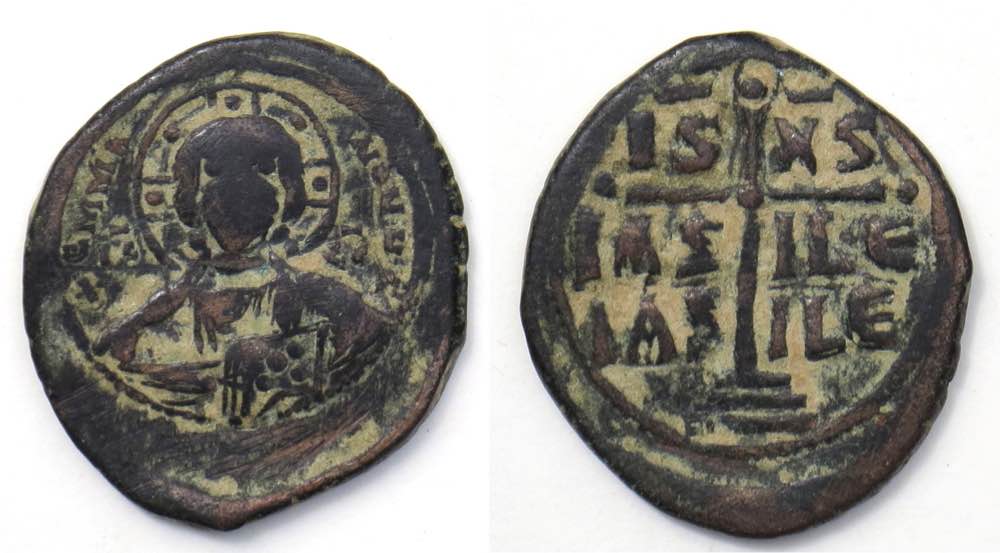
Byzantine Anonymous Folles of Classes B through K
(Go to the main page on anonymous folles. Go to the page on Class A.)
(Skip down to Class C, D, E, F, G, H, I, J, K)
What's new? 2024, April 23: Two new Class D examples.
2024, March 19: Font and image sizes increased. Another Class H coin.
2023, August 21: An example of the Amorium anonymous type.
2021, May 30: Additional examples of Class G, Class H.
Contents: This page has examples of Classes B through K and the Amorium type, including overstrikes, and then a few imitations.
For frequencies of these types, see the table of frequencies on the main page.
Dates. The dates of some of these classes remain uncertain. The first line of each class gives the Sear attribution which coincides with a single reign. The first line also gives Grierson's DOC attribution which is not quite the same and puts each of Classes A2-D in parts of two reigns.
Class A has its own page.
Class B, Sear 1813. (Sear Basil II & Constantine VIII, 976-1028). DOC pl. 55, page 676f, dated "c. 1030/35 - 1042(?)," Michael IV, 1034-1041.
Obverse: Facing bust of Christ, nimbate with small square of big dot in the limbs, holding gospels (with a pattern of five dots)
Reverse: cross on three steps, three-line legend:
IS XS above crossbar on either side, bar above letters (denoting an abbreviation)
bAS ILЄ
bAS ILЄ

Class B. Sear 1823. Michael IV, 1034-1041
30-27 mm. 11.04 grams.
A single large dot in the nimbus. A scarce variety.
Class B coins do not have a wide variety of ornaments like those of Class A2. They come with a single dot in the nimbus (as above) or a small square (next). An article by Orestes Zervos, "The substantive varieties of anonymous folles of Class B," (available on Academia.edu) identifies six varieties, five of which are very scarce and, he says, generally overlooked. The main variety has the square in the nimbus and pellets in the upper angles of the nimbus (next).
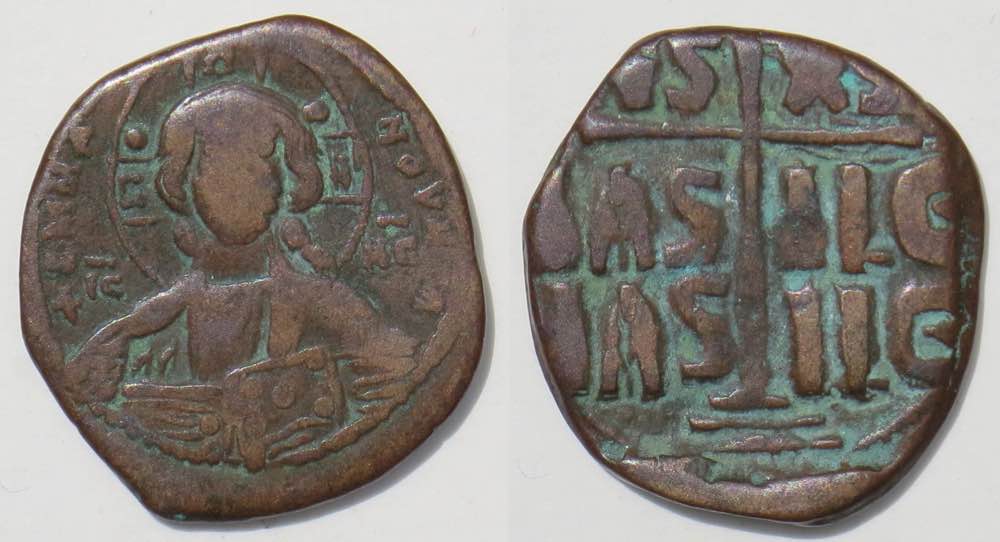
Class B. Sear 1823.
30-27 mm. 10.35 grams.
Small square in the nimbus.
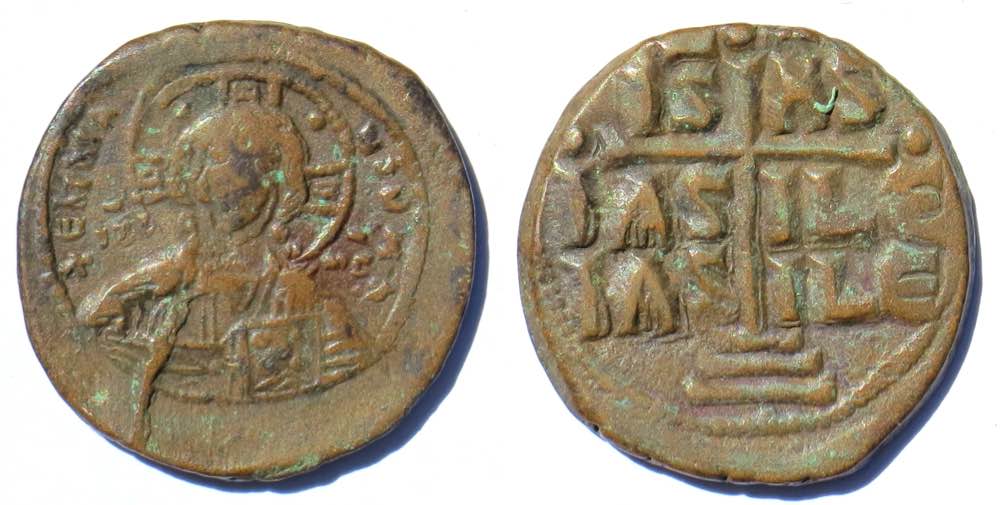
Class B. Sear 1823.
30-29 mm. 9.82 grams.
Small square in the nimbus.
Some folles of Class B are overstruck on folles of Class A, proving Class B is later. According to Morrison, Class B coins that are not overstruck average 9.92 grams (and most are c. 30 mm). Larger examples are likely overstruck. This example is repeated from the main page:
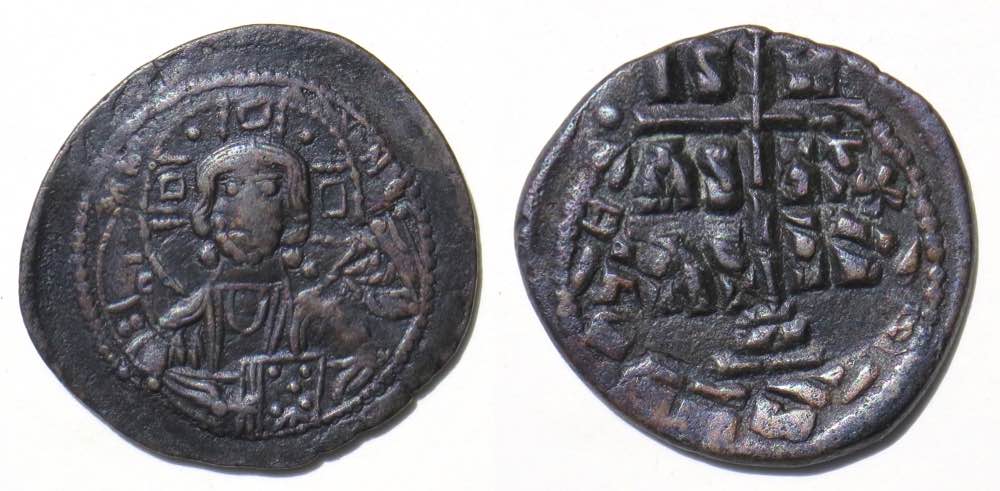 Class B over Class A. Sear 1823 over Sear 1813.
Class B over Class A. Sear 1823 over Sear 1813.
[Repeated from the main page.]
Large! 36-34 mm.
The image is oriented so the Class B reverse is up. The undertype has its top at 4:00 and the "+" of the first line of the four-line legend is clear at 2:00 and its end is clear at 5:30. The bottom decoration of the Class A undertype is at 9:30.
Class B is usually close to 30 mm., whereas Class A, which latest a long time, can be from 25 to 35 mm. This Class B was overstruck on a very large (probably early) Class A of 36-34 mm.
So, Class A is before Class B.
Class C. Sear 1825. (Sear Michael IV, 1034-1041). DOC pl. 60, page 681, dated "1042(?) - 1050", Constantine IX, 1042-1055.
Obverse: 3/4 length standing figure of Christ, right hand raised inward in benediction
Reverse: Jeweled square cross, legend in two lines
IC XC (Jesus Christ) bars above (denote abbreviations)
NI KA (conquers)
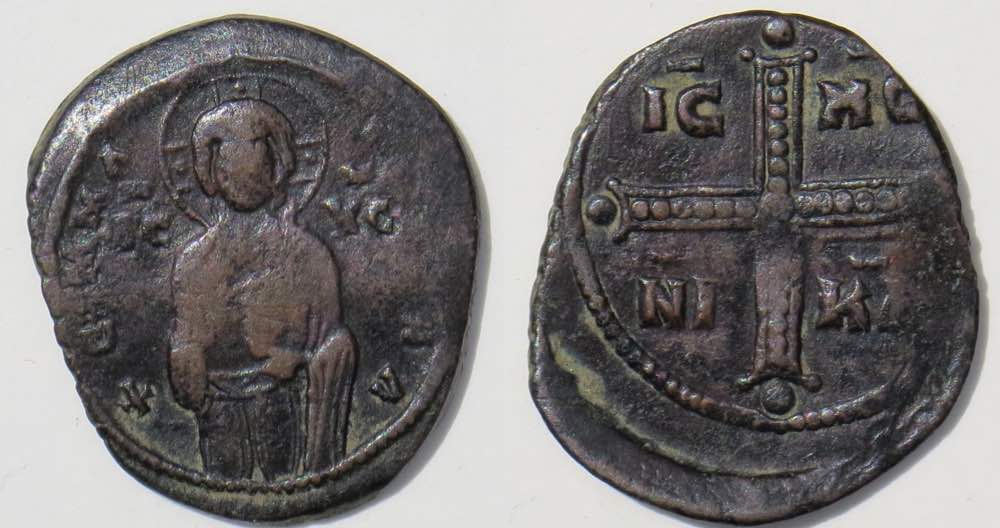
Class C, Sear 1825
29-26 mm. 8.44 grams.
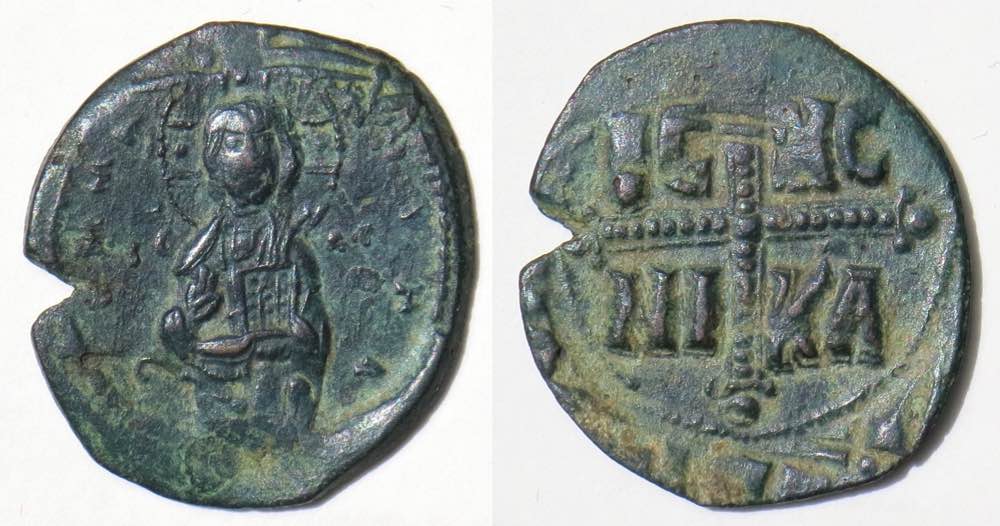
Class C over Class B. Sear 1825 over Sear 1823.
30-27 mm. 6.36 grams.
Overstruck on Class B. The reverse cross of Class B is upside down on the revere of this coin, with the crossbar and top line of the legend neara the edg of the flan at 6:30 and the steps showing at the top of the jeweled cross.
A bit of the bottom of the obverse type shows at 12:30.
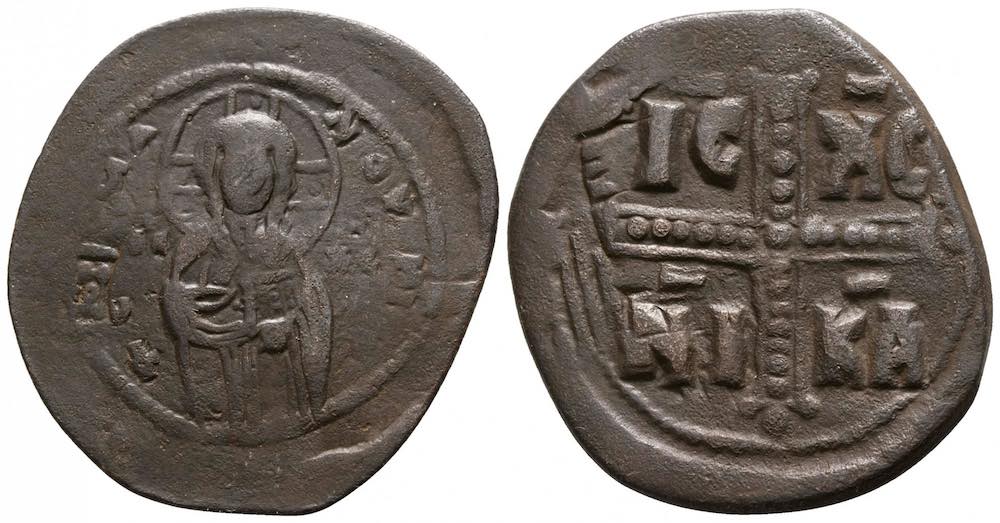
Class C over Class B.
31-28 mm. 7.84 grams.
The base of the Class B cross is clear at 8:00 on the reverse and some of the last line, bASILE, of the legend is legible. The top of the obverse of the undertype would be at 4:00 on this obverse, but it does not show.
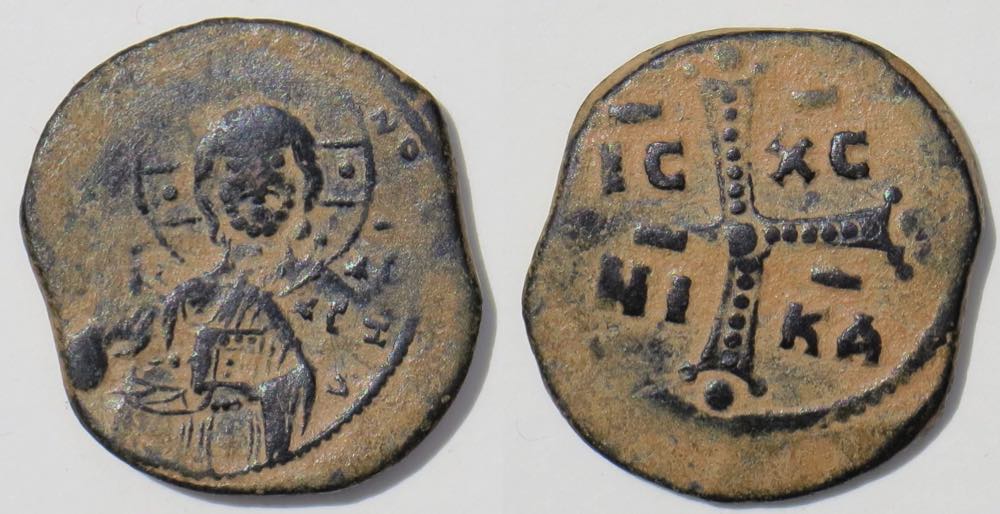 Class C over Class B, Sear 1825 over Sear 1813
Class C over Class B, Sear 1825 over Sear 1813
[Repeated from the main page]
27-26 mm. 9.90 grams.
The obverse is oriented so the bust of Christ from Class B (the undertype) is up.
The bottom of the 3/4-length figure of Christ of Class C is very clear with the bottom at 7:00.
The reverse shows a very clear Class C reverse, somewhat double struck.So, Class C is later than Class B.
It is unsual to have one side of the undertype so clear.
Class D. Sear 1836. (Constantine IX, 1042-1055). DOC pl. 60, page 686, dated "c. 1050 - c. 1060," Constantine IX, 1042-1055 and Constantine X, 1055-1067.
Obverse: Christ enthroned facing (thone with full back) holding book of gospels
Reverse: Three-line legend.
"- + -" above and "- crescent -" below
ISXS
bASILЄ
bASIL
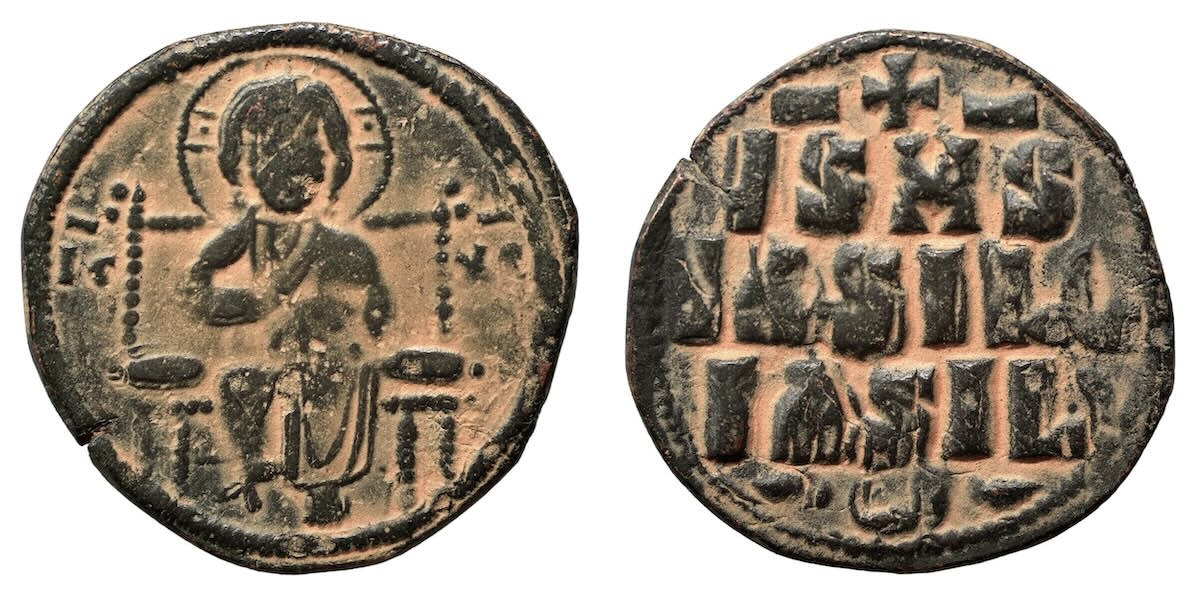
Class D, Sear 1836
27 mm. 8.36 grams.

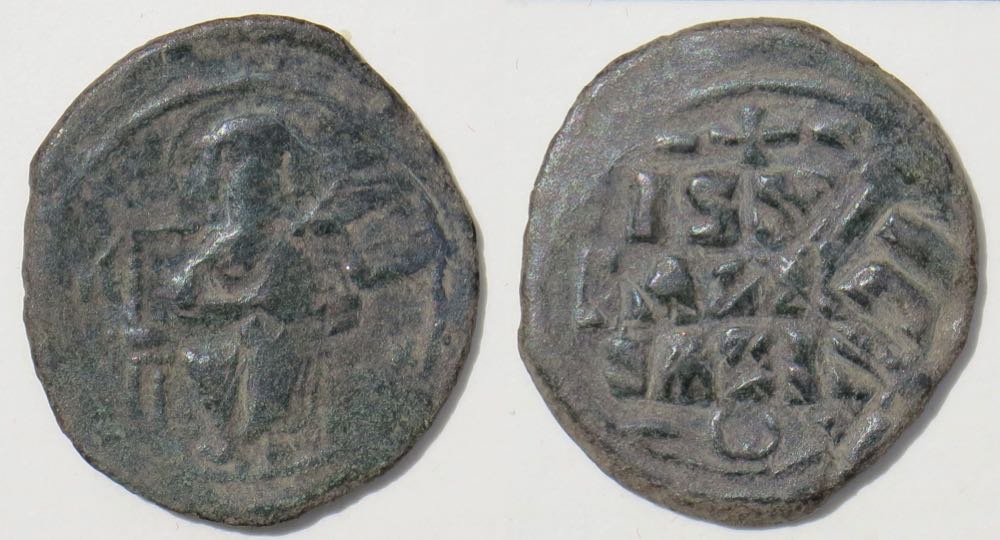
Class D over Class C.
[Repeated from the main page.]
32-29 mm. 11.32 grams.
The images are oriented so Class D is up.
The bottom of the obverse image of Class C (almost full-length figure of Christ) is visible at 2:00 on the obverse. The upper and left part of the reverse cross and IC is visible at 4:00 on the reverse.
So, Class D is later than Class C.

Class D over Class C
[Repeated from the main page]
33 mm (larger than ususal). 8.36 grams.
The obverse is oriented so Class D is up.
The jeweled cross of a Class C reverse can be seen under it from 8:30 to 2:00.
Because the reverse of C is under the obverse of D, the obverse of C ought to be under the reverse of D, but it is lost in the garbeled strike.

Class D, Sear 1836
25 mm. 8.68 grams.
Lovely earthen highlighting.
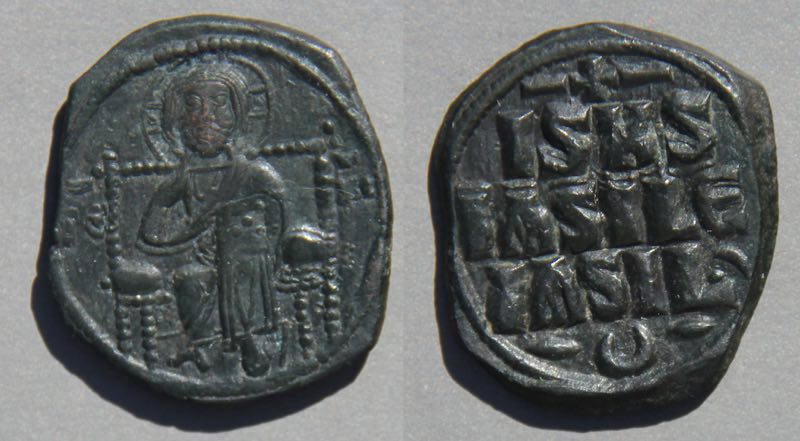
Class D. Sear 1836.
30-26 mm. 12.38 grams.
Nearly black.
Good, single, strike and remarkably good facial details.
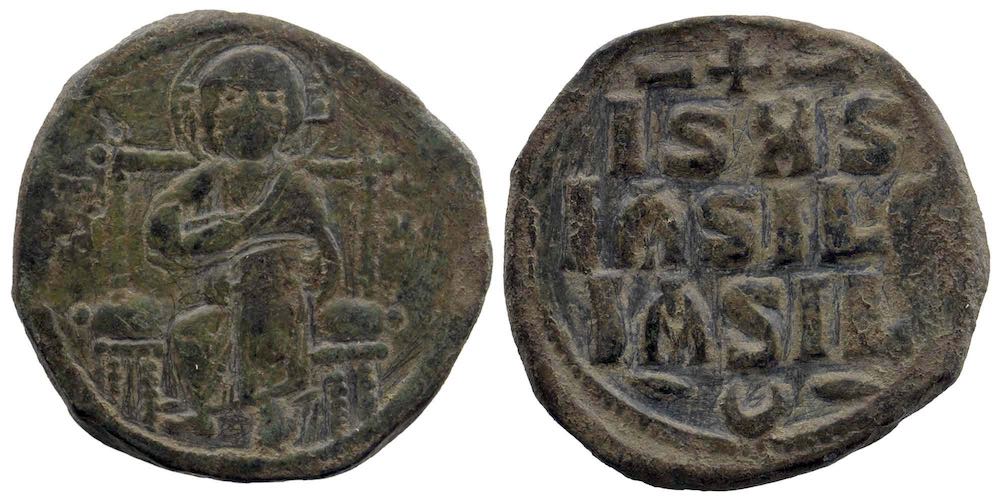
Class D. Sear 1836.
28-27 mm. 11.29 grams.
Class E. Sear 1855. (Constantine X, 1059-1067). DOC pl. 61, page 688, dated "c. 1060."
Obverse: Bust of Christ facing, holding book of gospels in both hands
Reverse: Three-line legend:
ISXS
bASILЄ
bASIL
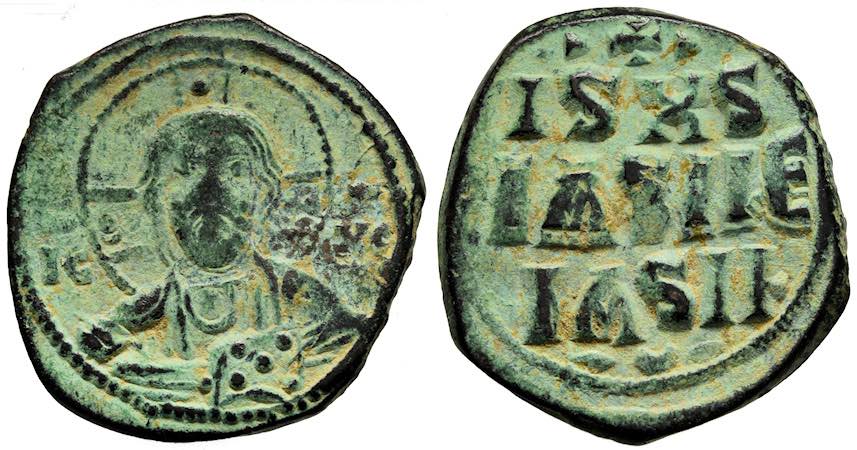
Class E. Sear 1855.
Constantine X, 1059-1067
27-26 mm. 9.50 grams.
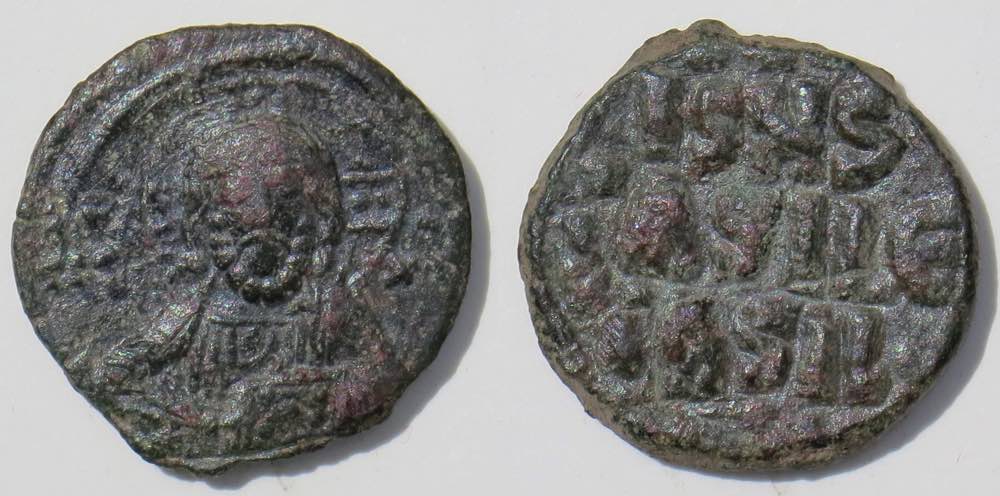
Class E. Sear 1855.
Constantine X, 1059-1067
25 mm. 9.61 grams.
Class F. Sear 1856.(Constantine X, 1059-1067). DOC pl. 61, page 690, dated "c. 1060 - c. 1065."
Obverse: Christ seated facing on throne without back, holding gospels in left and raising his right hand out in benediction
Reverse: Three-line legend with "- + -" above and wide cross below.
ISXS
bASILЄ
bASIL

Class F. Sear 1856.
Constantine X, 1059-1067
26-24 mm. 6.41 grams.
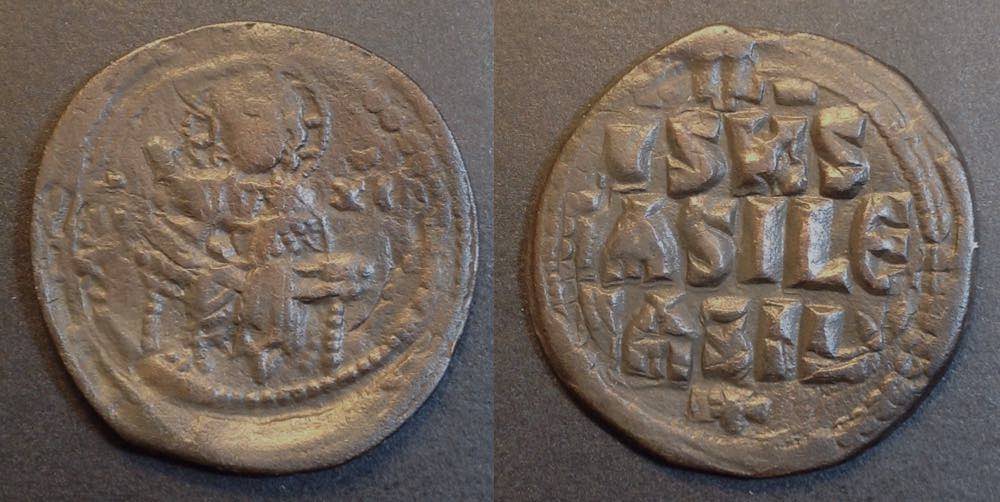
Class F. Sear 1856.
Constantine X, 1059-1067
29-28 mm. 6.71 grams.
Looks overstruck, but the undertype is almost obliterated and uncertain.
Class G. Sear 1867. (Romanus IV, 1068-1071). DOC pl. 61, page 692, dated "c. 1065 - c. 1070."
Obverse: Facing bust of Christ, nimbate, with nothing in the limbs. IC XC (bars above)
Reverse: Facing bust of the Virgin Mary, orans (with hands out and up, as shown). MP ΘV (bars above)

Class G. Sear 1867.
Romanus IV, 1068-1071
28-26 mm. 7.30 grams.
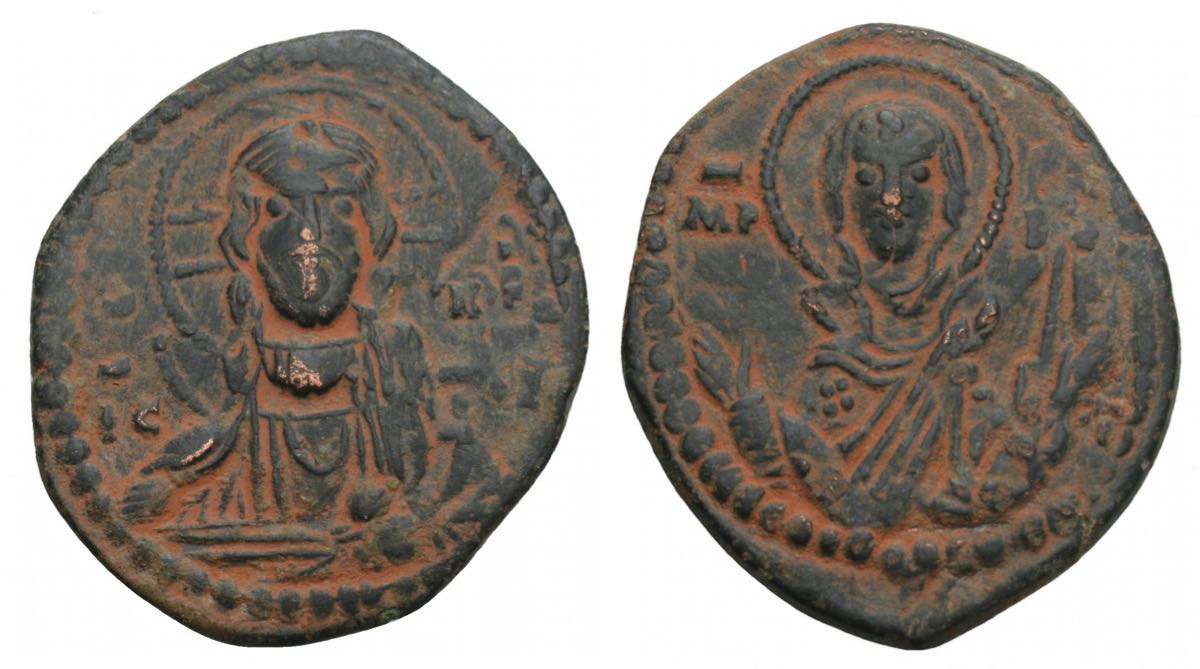
Class G. Sear 1867.
Romanus IV, 1068-1071
29-25 mm. 5.66 grams.
Class H. Sear 1880. (Michael VII, 1071-1078). DOC pl. 68, page 694, dated "c. 1070 - c. 1075."
Obverse: Bust of Christ facing, holding gospels and nimbate with X-like symbol in limbs.
Reverse: Patriarchal cross (with two crossbars) with globes at the ends of the crossbars, dots in the field, and a floral design at the base.
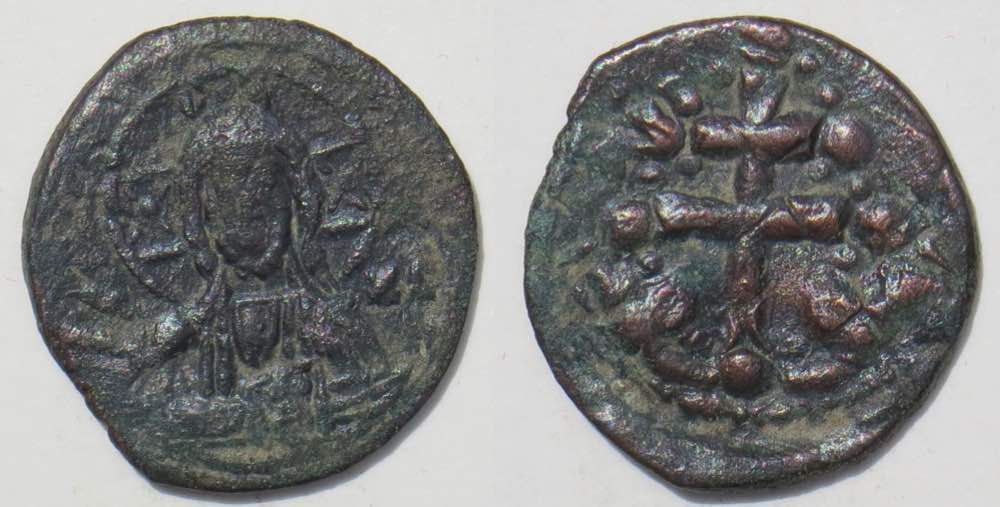
Class H. Sear 1880.
Michael VII, 1071-1078
23 mm. 4.45 grams.
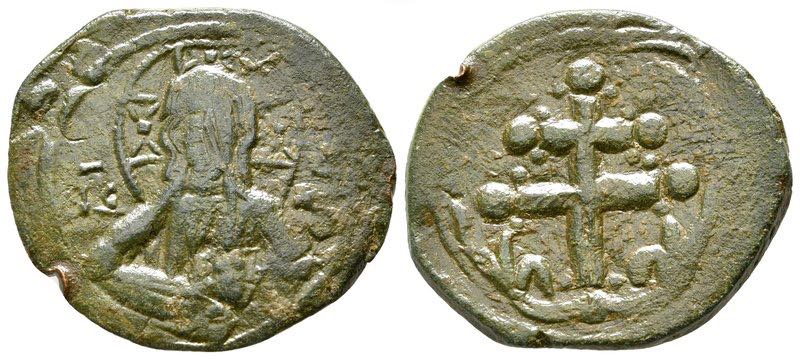
 Class H. Sear 1880
Class H. Sear 1880Class I. Sear 1889. (Nicephorus III, 1078-1081). DOC pl. 68, page 694, dated "c. 1075 - c. 1080."
Obverse: Bust of Christ facing, holding gospels and nimbate with large dot in limbs.
Reverse: Latin cross with X in the middle, globes at the ends, and a floral design at the base.
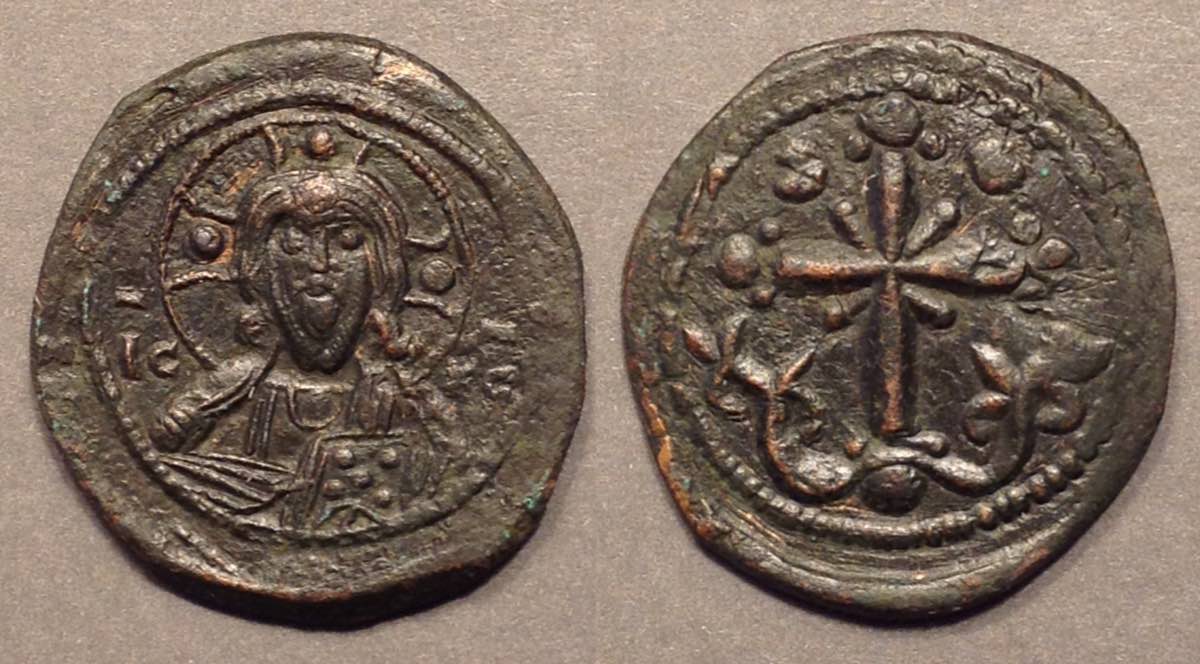
Class I. Sear 1889.
Nicephorus III, 1078-1081
25.4-24.0 mm.
6.18 grams.

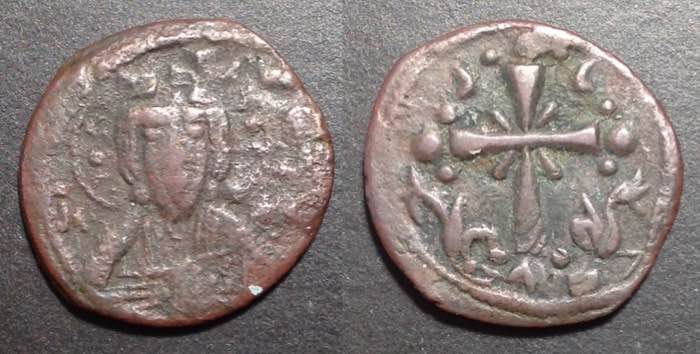
Class I. Sear 1889.
Nicephorus III, 1078-1081
23 mm. 3.87 grams.
Facing Christ
Elaborate cross with floral decoration at the bottom
Lovely red patina. Remarkably fine reverse.
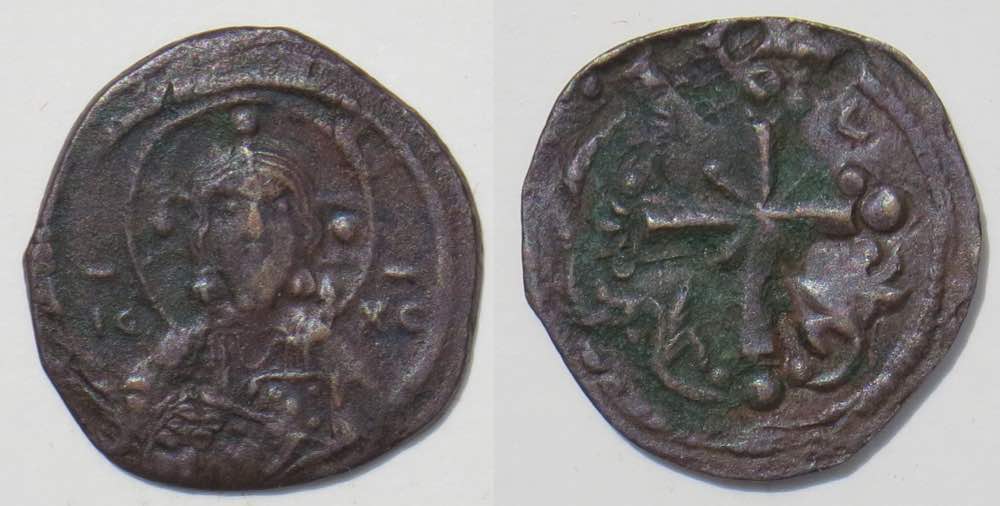
Class I. Sear 1889.
Nicephorus III, 1078-1081
23 mm. 3.84 grams.
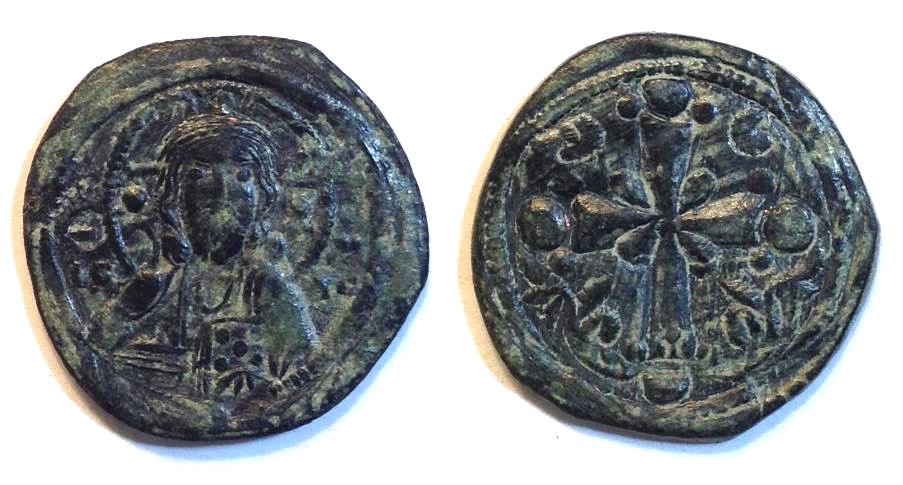
Class I. Sear 1889.
Nicephorus III, 1078-1081
24 mm. 5.38 grams.
Class J. Sear 1900. (Alexius I, 1081-1118). DOC pl. 68, page 696. dated "c. 1080 - c. 1085."
Obverse: Bust of Christ facing, holding gospels and nimbate with 5-dot pattern in limbs.
Reverse: Cross with large crescent upwards at base, globes
This type is not in BMC because at the time it was thought to be of the Crusaders at Edessa.

Class J. Sear 1900.
Alexius I, 1081-1118
24 mm. 5.46 grams.
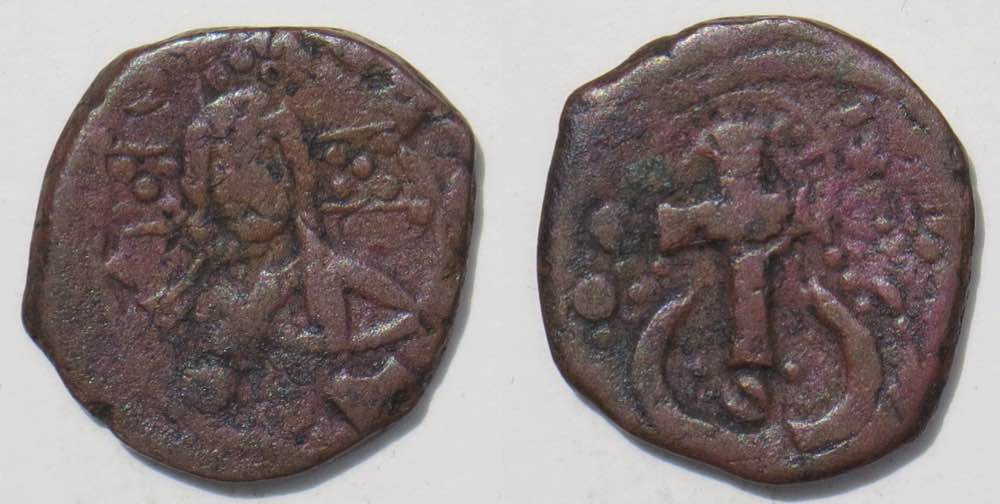
Class J. Sear 1900.
Alexius I, 1081-1118
24-22 mm. 7.09 grams.
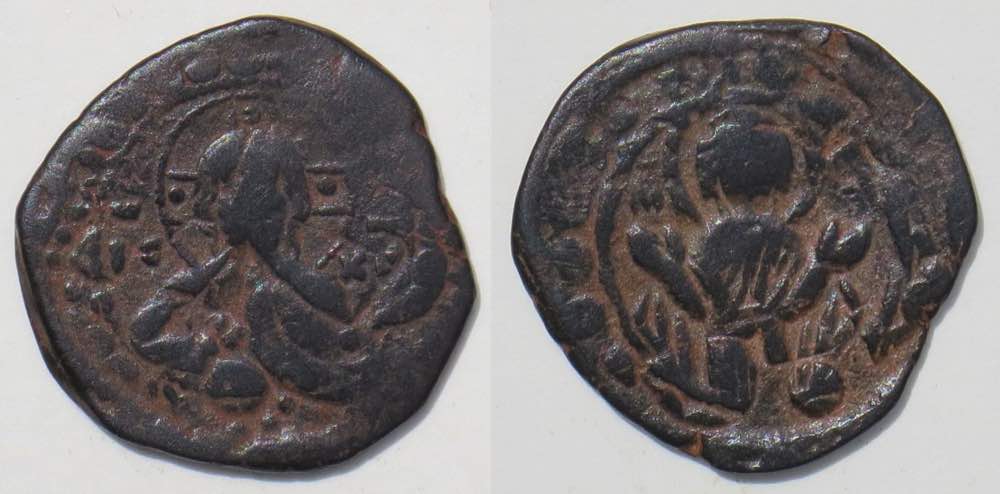
Class K. Sear 1901
Alexius I, 1081-1118
25 mm. 5.17 grams.
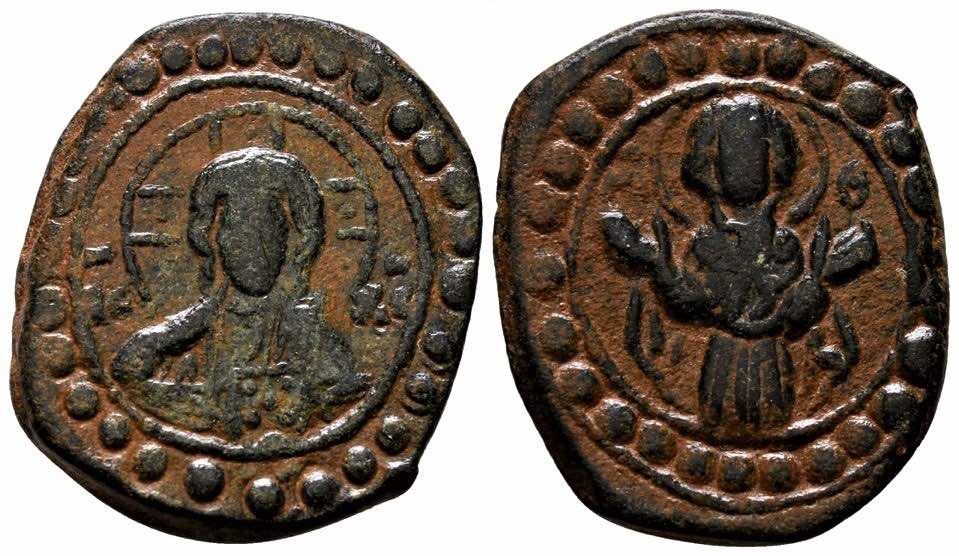
Class K. Sear 1901
Alexius I, 1081-1118
25-22 mm. 6.92 grams.
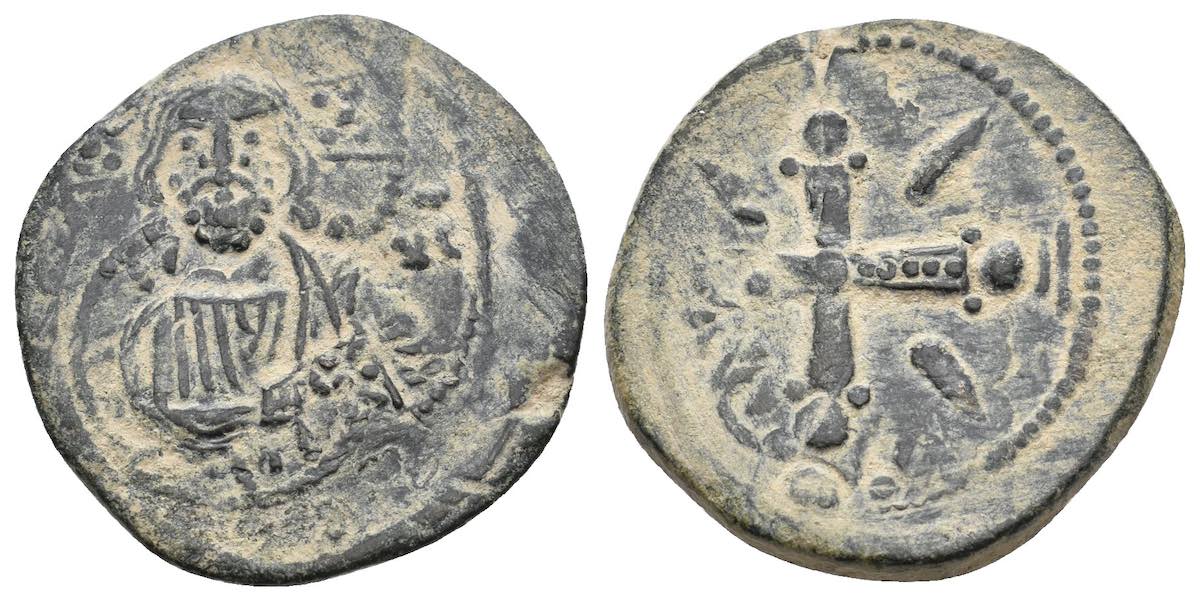
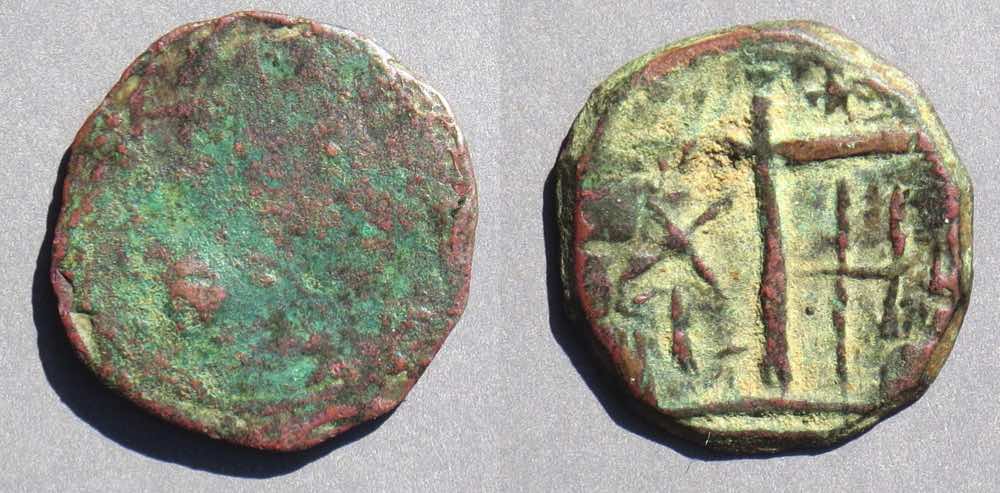 24-23 mm. 5.64 grams.
24-23 mm. 5.64 grams.
What is it?
Could it be a Class B imitation?
The size is about right.
Look very hard and use your imagination and you might make out a facing bust of Christ on the obverse, or at least a bit of a halo (nimbus).
The cross on the reverse is clear. However, the usual lettering is not reproduced at all. I am not at all certain this is an imitation of Class B.
 A Class B obverse with a Class C reverse.
A Class B obverse with a Class C reverse.
27-26 mm. 7.33 grams.
Possibly an ancient imitation, as opposed to an official overstrike.
Look at the Class C reverse. The jeweled cross has fewer jewels than normal.
The lettering should be
IC XC
NI KA
and some of the letter forms are right, but the X is not and "NI KA" is not correct either.
The obverse of Class C should be 3/4 length figure, but this coin has a facing bust of Christ like Classes B and A.
If the orientation of the reverse is right, the die axis is 11:00, not the regular 6:00.
 28-27 mm. 7.58 grams.
28-27 mm. 7.58 grams.
12:00 die axis.
A three-line reverse like Class E,
but either extremely blundered or in a strange language,
possibly Armenian or Georgan. https://rpc.ashmus.ox.ac.uk/volumes
This coin was the subject of a CoinTalk thread:
https://www.cointalk.com/threads/byzantine-anonymous-bronze-imitated-in-a-different-script.317759/#post-3100106
The collected wisdom did not manage to identify it.
Return to the main page on anonymous folles.
Go to the page on Class A anonymous folles.
Go to the Table of Contents for the entire educational site.